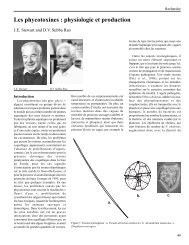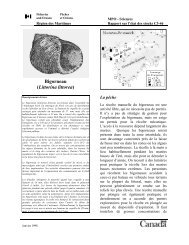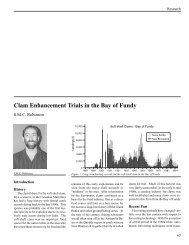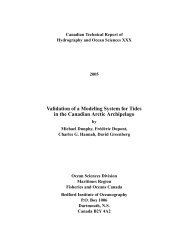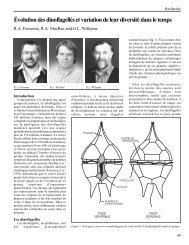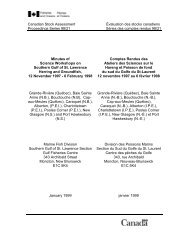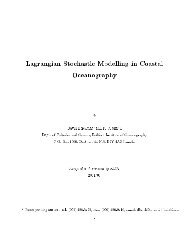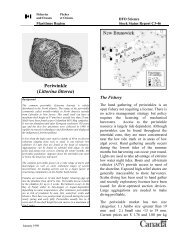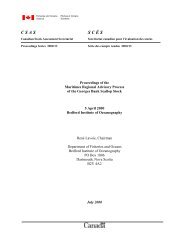bedford institute of oceanography 2001 in review - Région des ...
bedford institute of oceanography 2001 in review - Région des ...
bedford institute of oceanography 2001 in review - Région des ...
Create successful ePaper yourself
Turn your PDF publications into a flip-book with our unique Google optimized e-Paper software.
SCIENCE ACTIVITIES / Ocean SciencesOcean SciencesTales <strong>of</strong> the Unexpected from the Scotian Shelf- Erica Head and Leslie HarrisS<strong>in</strong>ce 1998, the Ocean Sciences Division has been collect<strong>in</strong>g hydrographicdata and chemical and biological samples at selected sites onthe Scotian Shelf. The collections are made each spr<strong>in</strong>g and fall as part<strong>of</strong> the Atlantic Zone Monitor<strong>in</strong>g Program (AZMP). This programwas set up to observe climate-related changes <strong>in</strong> environmental andbiological conditions <strong>of</strong> the lowest levels <strong>of</strong> the food cha<strong>in</strong> (plankton)that might affect the status <strong>of</strong> higher trophic levels <strong>in</strong>clud<strong>in</strong>gcommercial fish species. Zooplankton, the pr<strong>in</strong>cipal vectors for thetransfer <strong>of</strong> energy from the primary producers (phytoplankton) tothe higher trophic levels, are collected us<strong>in</strong>g plankton nets fitted witha 0.2mm mesh. This article <strong>des</strong>cribes several recent unusualzooplankton observations.Occurrence <strong>of</strong> a bloom <strong>of</strong> an exotic phytoplankton speciesOver the last few deca<strong>des</strong> the <strong>in</strong>troduction and geographic spread <strong>of</strong>exotic, or non-<strong>in</strong>digenous, species has <strong>in</strong>creased dramatically. Thechief mechanism is thought to be the ballast water exchanges carriedout by cargo ships. One well-known example is the <strong>in</strong>troduction <strong>of</strong>zebra mussels <strong>in</strong>to the Great Lakes. Introductions <strong>of</strong> non-<strong>in</strong>digenousphytoplankton are <strong>of</strong>ten unnoticed until they reach “nuisance” status.Here,we are report<strong>in</strong>g the occurrence <strong>of</strong> a bloom <strong>of</strong> a species <strong>of</strong> non<strong>in</strong>digenousdiatom on the Scotian Shelf, <strong>des</strong>cribed as a nuisancespecies elsewhere, which has had no recorded effects here.In the spr<strong>in</strong>g 2000, plankton tows from most <strong>of</strong> the central andwestern Scotian Shelf sampl<strong>in</strong>g sites conta<strong>in</strong>ed high levels <strong>of</strong> phytoplankton.This is not <strong>in</strong> itself unusual, s<strong>in</strong>ce many phytoplanktonspecies, especially diatoms, form long cha<strong>in</strong>s <strong>of</strong> cells that can getcaught up <strong>in</strong> the 0.2mm mesh. When look<strong>in</strong>g at our samples underthe microscope, however, we found that this was not the type <strong>of</strong>phytoplankton usually seen (Fig. 1). Instead, it was <strong>in</strong> the form <strong>of</strong>large <strong>in</strong>dividual diatom cells, shaped like petrie dishes, which hadboth diameter and height <strong>of</strong> approximately 0.25mm.The diatoms were identified as Cosc<strong>in</strong>odiscus wailseii (J. Mart<strong>in</strong>,DFO, St. Andrews). This species was orig<strong>in</strong>ally reported <strong>in</strong> only twoareas: the Pacific coast <strong>of</strong> North America and Japanese coastal waters.S<strong>in</strong>ce the late 1970s, however, C.wailseii has established itself as animmigrant <strong>in</strong> the waters around the United K<strong>in</strong>gdom and <strong>in</strong> the NorthSea. C. wailseii cells may be too big for many zooplankton, such as thecopepods <strong>in</strong> Fig. 1, to eat so that blooms may cause disruptions <strong>in</strong> thefood cha<strong>in</strong> at its lowest level. Also, it has been reported that C. wailseiican clog fish<strong>in</strong>g nets, by produc<strong>in</strong>g large amounts <strong>of</strong> mucilage, andthat it is noxious to Nori, a seaweed harvested <strong>in</strong> Japan. As yet,however no compla<strong>in</strong>ts have been reported <strong>of</strong> either <strong>of</strong> these potentialnuisance effects from around our coast.The history <strong>of</strong> occurrence <strong>of</strong> C. wailseii on the Scotian Shelf ispartially documented through Cont<strong>in</strong>uous Plankton Recorder (CPR)records. The CPR is a towed body, deployed from commercial ships,that collects, preserves, and saves plankton samples. C. wailseii did notFigure 1. Plankton net sample collected on Browns Bank <strong>in</strong> April 2000. Contents <strong>of</strong>the diatoms appear shrivelled due to chemical preservation. Preservation also<strong>des</strong>troys the colours <strong>of</strong> the phytoplankton and zooplankton (copepods)– photo by Dan Jackson.occur on the Scotian Shelf <strong>in</strong> the 1970s, but it had arrived by the early1990s. It is an <strong>in</strong>terest<strong>in</strong>g thought that the commercial vessels thatconduct long-term monitor<strong>in</strong>g <strong>of</strong> exotic species <strong>in</strong>vasions, such asthis one, may also contribute to their occurrence.Strange copepod mat<strong>in</strong>g behaviour on the Scotian ShelfOne species <strong>of</strong> copepod, Calanus f<strong>in</strong>marchicus, dom<strong>in</strong>ates thezooplankton <strong>in</strong> spr<strong>in</strong>g and early summer. Individuals spend thew<strong>in</strong>ter as pre-adults <strong>in</strong> the deep waters surround<strong>in</strong>g the shelf or <strong>in</strong> theshelf bas<strong>in</strong>s, but as spr<strong>in</strong>g arrives they swim up to the surface to moultand develop <strong>in</strong>to sexually mature males and females. Dr. CharlesMiller (Oregon State Univ.) has <strong>des</strong>cribed the mat<strong>in</strong>g process. Newlymoultedfemales perform a “hop and s<strong>in</strong>k” swimm<strong>in</strong>g rout<strong>in</strong>e, whilereleas<strong>in</strong>g a trail <strong>of</strong> pheromones that attracts the males. The malesswim <strong>in</strong> broad horizontal loops until they get near a female at whichpo<strong>in</strong>t their loops become smaller and three-dimensional. Someencounters do not result <strong>in</strong> successful mat<strong>in</strong>g, but <strong>in</strong> those that do,the male clasps the females and transfers a sac <strong>of</strong> sperm, called a spermatophore,to the genital segment <strong>of</strong> the female’s tail. This is thenormal rout<strong>in</strong>e, but samples collected from sites on the northeasternshelf (<strong>of</strong>f Louisbourg) <strong>in</strong> April 2000, conta<strong>in</strong>ed products <strong>of</strong> someapparently sexually deviant behaviour.Firstly, we saw juveniles <strong>of</strong> another related copepod species(Calanus hyperboreus) with spermatophores attached to one <strong>of</strong> theirtail segments (Fig. 2). These juveniles were approximately the samesize as female C. f<strong>in</strong>marchicus. Male C. f<strong>in</strong>marchicus were the only18 / BIO-<strong>2001</strong> IN REVIEW




